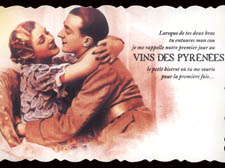|
|
 |
| |

A postcard advertising wines of Pyrenees |
It’s wine-making as it should be
The wine-makers of south west France are traditionalists but are not afraid of experimenting.
WE arranged a tasting of wines from south-west France in July for the Castlehaven Community Centre in Chalk Farm, and last week we were at a tasting held by local growers from the same region. This is a sprawling area ranging from near Bordeaux in the north and Toulouse in the east to the Spanish border in the south.
In mediaeval times the English valued its wines (which include Armagnac brandy) more highly than those of Bordeaux. Up to the phylloxera outbreak (before the 1880s), it was among France’s most productive wine regions, easily outstripping Bordeaux in terms of volume. It has taken more than four generations since phylloxera to recover even a small fraction of its previous output.
This renewal started in the 1950s and early 1960s, when French consumers, unwilling to pay the prices demanded for top Bordeaux, looked for something better than was generally available.
The area seemed to be doing well when heavy frosts brought disaster in 1956, all but wiping out the crop. Prompt replanting was rewarded by a short boom in Cahors in the early 1970s. Since then, the area as a whole has made steady progress, gradually improving its status with a number of Vins Délimité de Qualité Supérieure (VDQS) rising to full Appelation d’Origine Contrôllée (AOC).
Interestingly, micro-oxygenation, a process of infusing small measured amounts of oxygen at crucial stages in the fermentation and maturing of wine, was pioneered in Madiran at the southern tip of the Armagnac region. It was used to break down the fierce tannins of the local grape, appropriately called tannat, one of the oldest strains of grape in the world. Initially a response to a particular problem, it is now more generally – and controversially – used to speed up the ageing of wines.
In contrast to this technology, some growers continue to ferment their wine in barrels, a traditional practice now being revived in wine regions throughout the world.
This indicates that growers in the South West are happy to combine traditional methods with modern technology. The recent wine tastings held by local growers in London and Dublin have been used for two purposes, to promote an identity for the area and to preserve its individuality. These two goals aren’t necessarily at odds, but they do create tensions which make the area interesting.
The region is so diverse that we cannot suggest a single wine typical of it. This is the region’s strength. Its wines reward effort invested in getting to know them. They have little in common with New World wines, much less other French regions.
Grapes indigenous to this region, such as tannat (red) and petit and gros manseng (white) are blended with better known varieties like malbec, cabernet sauvignon, cabernet franc or merlot. Styles vary, with some winemakers producing wines that could come from the New World, whilst others stick to “rustic” tannic wines needing to be well aged.
This is winemaking as it should be – traditional but not afraid of experimenting. Growers have kept their original grape varieties giving their wines a range of identities. Côtes de St Mont alone has at least ten types of grape. Consequently, applying modern technology can best be described as “work in progress”.
When you approach these wines, forget about the “perfect” wine. Shun words such as “brilliant” and “dazzling”. These are wines to be explored, debated, discussed and disagreed over. The wine makers of the South West have further to go in working out what sort of red wine they want to produce. But this is what makes their wines significant and interesting.
|
 |
| |
| |
|
 |
|









